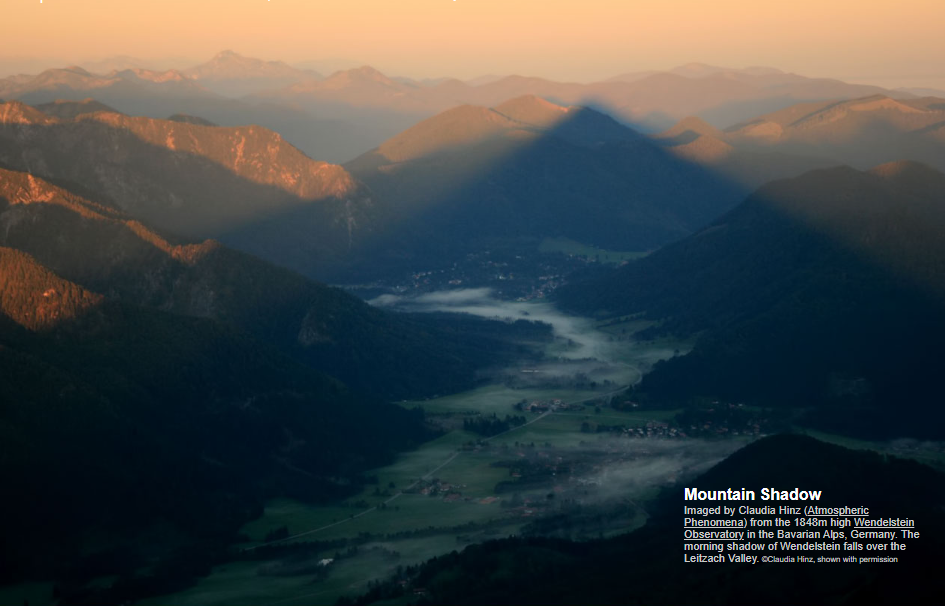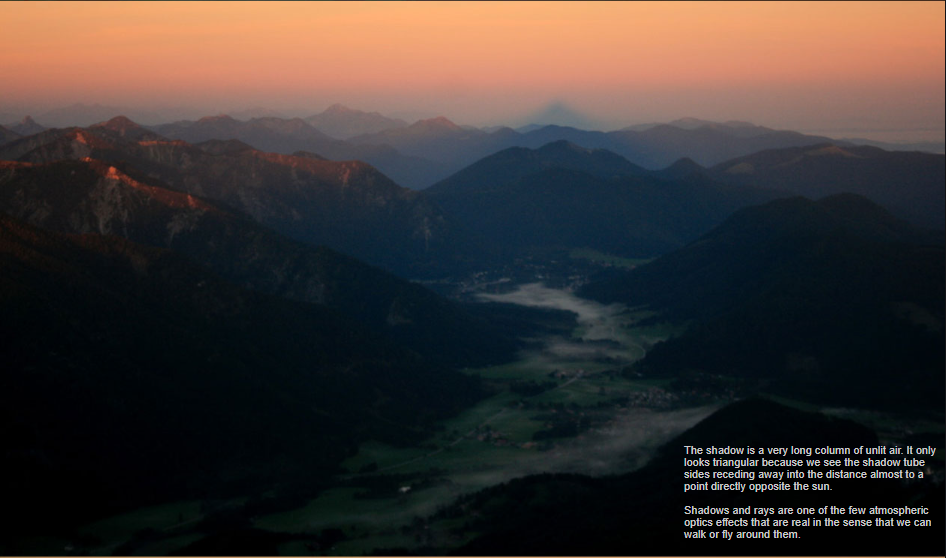OPOD - Wendelstein Mountain Shadow
OPOD - Wendelstein Mountain Shadow: A Spectacular Atmospheric Phenomenon
Have you ever witnessed the mesmerizing sight of a mountain casting its shadow over a valley? The phenomenon, known as the Wendelstein Mountain Shadow, is a captivating display of atmospheric optics. Today, we delve deeper into this intriguing natural occurrence and explore its remarkable features.
Captured by Claudia Hinz from the Wendelstein Observatory, nestled in the Bavarian Alps of Germany, the morning shadow of Wendelstein extends gracefully over the Leitzach Valley. Standing at an impressive height of 1848 meters, the mountain creates a striking silhouette against the horizon. The image, with permission from Claudia Hinz, showcases the sheer beauty and grandeur of this phenomenon.
The Wendelstein Mountain Shadow appears as a long column of unlit air, stretching far into the distance. Although it may seem triangular in shape, this illusion arises from our perspective. The sides of the shadow tube gradually recede into the distance, converging towards a point directly opposite the position of the sun. This convergence creates the perception of a triangular shadow, adding to its mystique.
Shadows and rays are among the few atmospheric optics effects that we can physically experience by walking or flying around them. Unlike many other atmospheric phenomena that appear intangible and elusive, these shadows offer a tangible interaction with our surroundings. As we move through their presence, we witness their dynamic nature and observe how they transform based on our perspective.
The Wendelstein Mountain Shadow, like other shadow phenomena, occurs due to the interaction between sunlight and objects obstructing its path. When the sun's rays encounter the massive bulk of the mountain, they are blocked from reaching certain areas behind it. As a result, a shadow is cast onto the landscape, creating a stark contrast between light and darkness.
To fully appreciate the complexity and beauty of the Wendelstein Mountain Shadow, it is essential to understand the science behind it. The formation of this phenomenon relies on the principles of light propagation and the interaction between light and matter. As sunlight passes through Earth's atmosphere, it undergoes various processes, including scattering, refraction, and absorption. These interactions shape the behavior of light rays, giving rise to the mesmerizing effects we observe in the sky.
The Wendelstein Mountain Shadow serves as a reminder of the intricate interplay between natural elements and atmospheric conditions. The precise alignment of the sun, the mountain, and the observer's position determines the extent and shape of the shadow. Each day, as the sun traverses its path across the sky, the shadow's position and size change accordingly. This dynamic nature adds an element of unpredictability to the phenomenon, making each sighting a unique and awe-inspiring experience.
As we delve into the world of atmospheric optics, it becomes evident that there is much more to explore and discover. The Wendelstein Mountain Shadow offers a glimpse into the vast array of captivating natural phenomena that surround us. By studying and appreciating these wonders, we gain a deeper understanding of the intricate workings of our planet and the beauty that lies within our atmosphere.
Next time you find yourself in the presence of a mountain casting its shadow over a valley, take a moment to marvel at this breathtaking display. The Wendelstein Mountain Shadow invites us to pause, appreciate, and contemplate the wonders of our world, reminding us of the captivating beauty that can be found in even the simplest of natural occurrences.

Mountain Shadow
Imaged by Claudia Hinz (Atmospheric Phenomena) from the 1848m high Wendelstein Observatory in the Bavarian Alps, Germany. The morning shadow of Wendelstein falls over the Leitzach Valley. ©Claudia Hinz, shown with permission

The shadow is a very long column of unlit air. It only looks triangular because we see the shadow tube sides receding away into the distance almost to a point directly opposite the sun.
Shadows and rays are one of the few atmospheric optics effects that are real in the sense that we can walk or fly around them.

Note: this article has been automatically converted from the old site and may not appear as intended. You can find the original article here.
Reference Atmospheric Optics
If you use any of the definitions, information, or data presented on Atmospheric Optics, please copy the link or reference below to properly credit us as the reference source. Thank you!
-
<a href="https://atoptics.co.uk/blog/opod-wendelstein-mountain-shadow/">OPOD - Wendelstein Mountain Shadow</a>
-
"OPOD - Wendelstein Mountain Shadow". Atmospheric Optics. Accessed on November 26, 2024. https://atoptics.co.uk/blog/opod-wendelstein-mountain-shadow/.
-
"OPOD - Wendelstein Mountain Shadow". Atmospheric Optics, https://atoptics.co.uk/blog/opod-wendelstein-mountain-shadow/. Accessed 26 November, 2024
-
OPOD - Wendelstein Mountain Shadow. Atmospheric Optics. Retrieved from https://atoptics.co.uk/blog/opod-wendelstein-mountain-shadow/.